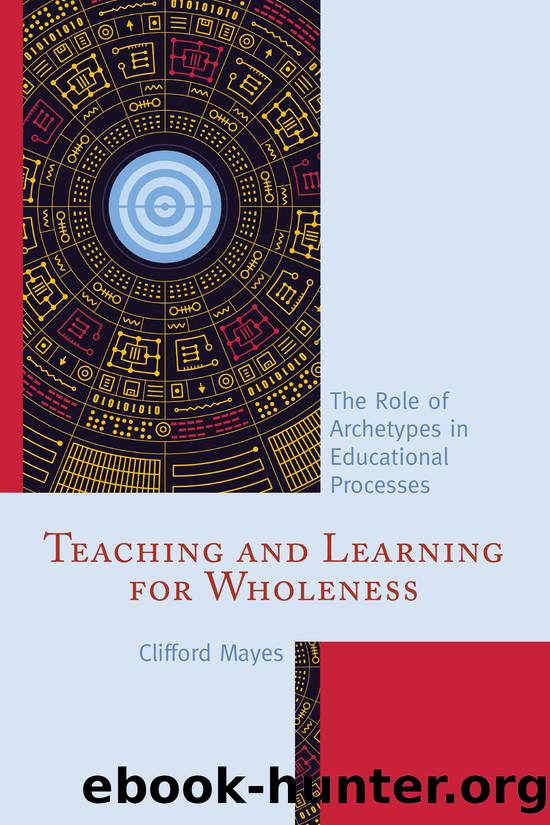Teaching and Learning for Wholeness by Mayes Clifford;

Author:Mayes, Clifford;
Language: eng
Format: epub
Publisher: Rowman & Littlefield Publishers, Incorporated
Chapter 5
In the Light of the Shadow Curriculum
In the first part of this chapter, let us first further look into some of the territory we have covered by going more deeply into archetypal shadow dynamics in teaching and learning, for they often constellate upon the ongoing call to adventure throughout the lifecycle of the class. Although the shadow may appear in any classroom at any time, it is especially prominent when the student is being encouraged to examine sensitive commitments that he has brought to the class.
The second part of this chapter is a closer look at Jungâs studies in alchemy as symbolic of the individuating psyche. This provides us with unique and uniquely powerful pedagogical symbols and terms.
Third follows a discussion of what I will call the âshadow curriculum.â This involves Jungâs idea of âthe inferior function.â
Finally, we consider the Jungian notion of a collective cultural conscious and its archetypal shadow, applying these ideas to current multicultural educational theory and practice.
We will see how much light can be gathered from the archetype of the shadow in the classroom.
Part One
More on the Heroâs Journey and Its Educational Implications
âEducation for individuation,â another term for education in the spirit of the symbol, revolves around the holistic well-being of the student, including her cognitive growth, of course, but with a special emphasis on her psychospiritual development (Mayes, 2005a, 2007, 2009a). Education for individuation aims at something akin to what the great 20th-century Curriculum Theorist Duane Huebner characterized in theological language as âeducation for ultimacyâ under the beckoning âlure of the transcendentâ (1999).
In both education for individuation and education for âUltimacyâ (Tillich, 1956), the student is invited to appropriate and employ what happens in the classroom in order to enrich her ever more vibrant and creative subjectivity. The focus is thus on the studentâs existential project of forging satisfying and evolving life narratives as they move toward individuation against the backdrop of the eternal (Ricoeur, 1976).
A challenge in education for individuation, however, is that the student may register the call for profound transformation, in not only cognitive but also deep psychospiritual areas of his being, as a threat to who and what he isâa perceived danger to his existence as it is presently constituted by myriad influences and commitments. This may give rise to a wide range of emotions in the student. In some students, those emotions may be resistive and even aggressive.
This can cause the studentâs shadow to constellate, which he then projects onto the teacher in a classic case of negative transference. Such negative transferences are called âdystonicâ in psychoanalytic parlance.
The archetype of the puer or puella may constellate dystonically as the studentâs way of hunkering down in an act of rejecting the teacherâs call for him or her to relinquish a simplistic opinion. This is typically one cherished by his or her family and/or culture of origin. As we have seen throughout this book, a sound general rule in both educational theory and practice is that it is important to recognize
Download
This site does not store any files on its server. We only index and link to content provided by other sites. Please contact the content providers to delete copyright contents if any and email us, we'll remove relevant links or contents immediately.
Chicken Soup for the Soul Presents Teens Talkin' Faith by Jack Canfield(647)
Understanding PDA Autism in Kids: A Guide for Parents and Teachers to Support Neurodiverse Learners by Jehu Len(554)
The Victorian Era: A Captivating Guide to the Life of Queen Victoria and an Era in the History of the United Kingdom Known for Its Hierarchy-Based Social Order by Captivating History(422)
Brain Teasers to Build Critical Thinking Skills by Safarova Kris(411)
Brain Teasers to Build Critical Thinking Skills: Brain Exercises for Tech, Banking, Case Interview Prep, and to Keep Your Mind Sharp by Kris Safarova(411)
100 Ideas for Secondary Teachers: Engaging Parents by Janet Goodall & Kathryn Weston(386)
Python 101 - Fundamentals by Sam(373)
Critical Curriculum Leadership : A Framework for Progressive Education by Rose M. Ylimaki(363)
Writing Solid Code: Development Philosophies for Writing Bug-Free Programs by Steve Maguire(356)
The Art of Emotional Validation: Improve Your Communication Skills and Transform Your Relationships by Validating Emotions and Feelings by Emily Wright(339)
Intersectionality in Educational Research by Dannielle Joy Davis; James L. Olive; Rachelle J. Brunn-Bevel; Susan R. Jones(331)
The Knights Templar: An Enthralling History of the Rise and Fall of the Most Influential Catholic Military Order by Wellman Billy(329)
A Beginner's Guide to SSD Firmware by Unknown(327)
The Future Knowledge Compendium by Ellyard Peter;(319)
How to be assertive in any situation by Hadfield Sue & Hasson Gill(310)
Making Connections in and Through Arts-Based Educational Research by Hala Mreiwed Mindy R. Carter Sara Hashem Candace H. Blake-Amarante(305)
Foundations of Educational Research by Victoria Elliott(305)
What Every Teacher Should Know about Learning, Memory, and the Brain by Tileston Donna E. Walker;(305)
Message from the Pleiades; The Contact Notes of Eduard Billy Meier v1 only by unknow(301)
